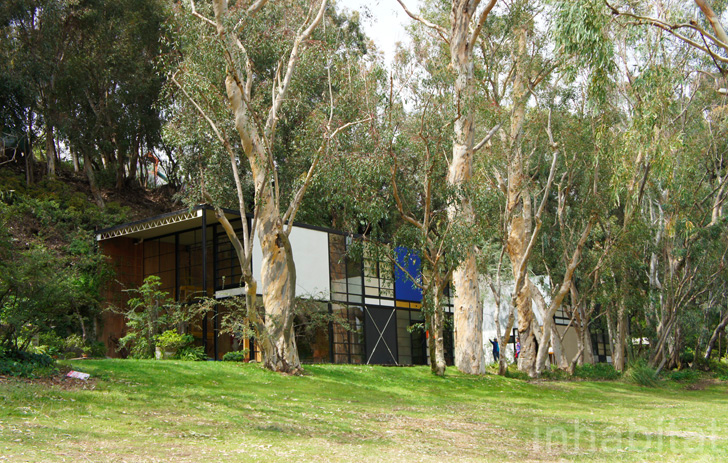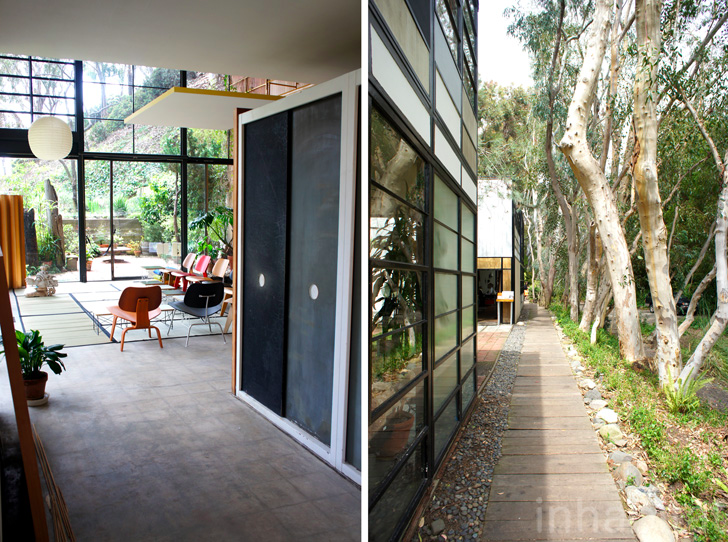Eames Case-study house #8
Eames House was built as a case-study house # 8 in Charles & Ray Eames in 1949. It is a collaboration between Charles and friends Eero Saarinen.
A case study house is a plan of John Entenza, chief editor of the magazine “Arts & Architecture”. Tied house manufacturers clients to architects, It was an experimental program to present new form of a residence in after the war era. Between 1945 and 1966, 36 projects were planned, of which 25 were built. Charles was one of the editorial boards of the magazine and Ray was handling cover design of magazine as an adviser.
(Archive article of case study house of Arts & Architecture website is here;
http://www.artsandarchitecture.com/case.houses/).
Photo Courtesy : inhabitat
Eames House was an exceptional building among case study houses in the following ways.
- It is a two-story building with a studio, not a flat private house.
- While other case study houses use original parts made by aeronautical material manufacturer, Eames House uses materials from the off-the-shelf items that Charles called “on the shelf”.
Especially in California architecture, many of the case study houses sold large openings for the ocean and the open view, Eames House sacrificed the view to the great ocean, Built close to the topography of the hill as if it were buried in half.
Contrasting with the fact that the case-study house # 9 (the house for John Entenza) by the same designer built next door is facing toward the ocean with a large glass opening.
The original plan of Eames House was a plan that a rectangular parallelepiped building with a long and large glass opening facing the sea and it was lifted from the slope by the cantilever in the same way as the Entenza residence.
It is said that Charles changed the plan by watching the same cantilever sketch which presented by Mies van der Rohe at exhibition at MOMA in 1947.
Architecture is the act of building “world”. Architecture is the act of creates its own existence to stand around the surroundings. It is easy to understand if you think of the architecture of Corbusier and Mies.
Eames’s initial plan resembles Mies’s sketch. It is exactly such an image.
In fact, however, the Eames house that was finished was completely different. Stuck closer to the hill, sticking to the ground, surrounded by trees, reflecting the silhouettes of the surrounding trees, combined with mass production industrial products, it seems like a warehouse with impressive impression.
Eames House strongly impresses that it is not a “world” building entity, but rather a “world” existence.
“Powers of ten”
The keyword of existence in the “world” reminds us of the video work “Powers of ten”
(YouTube is here https://www.youtube.com/watch?v=0fKBhvDjuy0) by Eames 28 years after Eames House.
“POWERS OF TEN” starts with an image of a male and a female are lying on the lawn on the banks of Lake Michigan from a distance of 10 0 0 (1 m 2 square), and the camera is in the air While drawing on to the 24th power of 10 to the far elevated view of the universe far from the solar system, the camera steeply descends from there, finally the body of the proton or neutron, It is a picture that shows the process from ultra micro viewpoint in 9 minutes of one scene.
“Powers of ten” intuitively understand that existence is in “world” and at the same time “world” is in existence.
Is not it the concept of Eames House itself?
The cookie-like comfortable sofa in the corner at the back of the living room of the house or the shelf decorating object that Eames and Ray gathered from the world was the “world”.
Since the Eames House, Charles Eames leaves the field of architecture and shifted to the design of video and communication.
In 1967, Charles said in a letter of the design competition of a new school building accompanying the relocation of a girls’ college Immaculate Heart.
“I hope that those students are migrates to barracks after the withdrawal of the troops, abandoned monasteries or some warehouses that are old and huge” (“Introduction to Eames” Eames Demetrios 2004)
It is a word that told Charles Eames the architectural ideals. It is inevitable that the act of building “building the world” inevitably has, in a sense, transcendental, self-righteousness is far beyond reverberation.
text by Tetsuya Omura



-1024x640.png)











